|
|
 |
Fiche d'espèce de Copépode |
|
|
Cyclopoida ( Ordre ) |
|
|
|
Lubbockiidae ( Famille ) |
|
|
|
Pseudolubbockia ( Genre ) |
|
|
| |
Pseudolubbockia dilatata Sars, 1909 (F,M) | |
| | | | | | | Ref.: | | | Sars, 1909 (p.4, Descr.F, figs.F); Lysholm & al., 1945 (p.43, Rem); Heron & Damkaer, 1969 (p.3, figs.F,M); Gardner & Szabo, 1982 (p.132, figs.F,M); Huys & Böttger-Schnack, 1997/98 (p.251, figs.F); Boxshall & Halsey, 2004 (p.577, p.576: fig.F); Vives & Shmeleva, 2010 (p.252, figs.F,M, Rem.) | 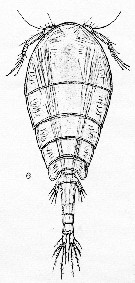 issued from : G.O. Sars in Res. Camp. Scient. Prince Albert Ier Movaco, 1938 (97). [Pl. I, Fig.6]. Female (from 38°-39°N, 26°W): 6, habitus (dorsal).
|
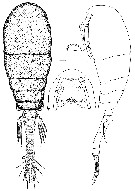 issued from : G.A. Heron & D.M. Damkaer in Smiths. Contr. Zool., 1969, 20. [p.2, Fig.1]. Female (from NE Pacific): a-b, habitus (dorsal and lateral, respectively); c, oral area (ventral view). Scale bar: 0.100 mm. Nota : Rostral region a widened ridge with central margin slightly depressed and indented. Prosome with distal corners of last thoracic segment flared laterally. Most of body surface, appendages, and mouthparts densely covered with minute papillae or minute setules. Urosome 5-segmented. Genital segment long, with lateral ovisacs. Caudal rami twice as long as wide and about the length of anal segment. P5 with free segment flat, with 4 setae of graduated length fringed with finely serrated lamellae ; inner set ais longest, extending to distal margin of 3rd urosomal segment. Fathered seta on body near insertion of free segment. P6 probably represented by small lobe, protruding laterally from aperture of oviduct and bearing 2 small spines.
|
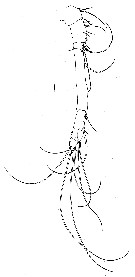 issued from : G.A. Heron & D.M. Damkaer in Smiths. Contr. Zool., 1969, 20. [p.3, Fig.2]. Female: A1. Scale bar: 0.100 mm. Nota : A1 6-segmented ; trace of suture dividing 5th segment on some specimens. Armature: segment I with 4 elements; II with 11 e; III with 2 spines; IV with 4 e; V with 9 e; VI with 8 e. Segment VI also with cluster of small spinules on inner margin.
|
 issued from : G.A. Heron & D.M. Damkaer in Smiths. Contr. Zool., 1969, 20. [p.4, Fig.3]. Female: a, A2; b, labrum. Scale bar: 0.100 mm. Nota : A2 subprehensile, with last 2 segments at right angle to 1st ; 2nd segment with 1 spine ; last segment armed with 2 spines along outer margin, terminating with 2 strong hooks, a short hook, and 3 setae, 1 plumose ; patches of setules on most surface. Labrum with 2 widely divergent ventral lobes ; flanges extending below free margin, each bordered with row of minute denticles.
|
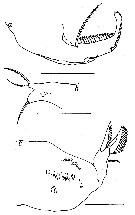 issued from : G.A. Heron & D.M. Damkaer in Smiths. Contr. Zool., 1969, 20. [p.4, Fig.4]. Female: a, Md; b, Mx1; c, Mx2. Scale bar: 0.100 mm. Nota : Md underlaying labrum, except for extreme basal portion ; flat, with sclerotized margins associated with base of anterior barbed seta and 2 posterior spines. Row of graduated disklike denticles borders outer convex side of blade, which ends in serrate tip, usually with 6 teeth (1 specimen with 5). Middle concave edge of blade armed with close-set row of dentiform spinules. Mx1 simple, divided distally into 2 lobes, the smaller with 2 barbed setae, the larger with 1 barbed seta and 1 very short seta. Small spinules on inner surface. Mx2 2-segmented ; 1st segment expanded, with clusters of denticles and spinules on both surfaces ; 2nd segment terminating with 1 spinulose spine and larger hyaline broader spine with longer spinules. Barbed seta inserted subapically.
|
 issued from : G.A. Heron & D.M. Damkaer in Smiths. Contr. Zool., 1969, 20. [p.5, Fig.5]. Female: Mxp. Scale bar: 0.100 mm. Nota : Mxp 4-segmented ; stout 2nd segment expanded, bearing irregular patches of spinules and 1 spine on anterior margin ; 3rd segment very short and unarmed ; terminal segment produced as recurved claw with spinous process on interior of dilated base ; more than one-half of concave margin bearing row of spinules.
|
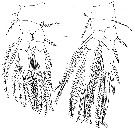 issued from : G.A. Heron & D.M. Damkaer in Smiths. Contr. Zool., 1969, 20. [p.6, Fig.6]. Female: a, P1; b, P2. Scale bar: 0.100 mm.
|
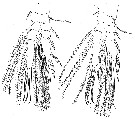 issued from : G.A. Heron & D.M. Damkaer in Smiths. Contr. Zool., 1969, 20. [p.7, Fig.7]. Female: a, P3; b, P4. Scale bar: 0.100 mm.
|
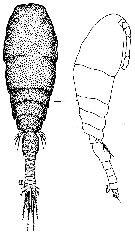 issued from : G.A. Heron & D.M. Damkaer in Smiths. Contr. Zool., 1969, 20. [p.8, Fig.8]. Male: a-b, habitus (dorsal and lateral, respectively). Scale bar: 0.100 mm. Nota : Most of body surface with papillae or setules as in female. Urosome 6-segmented. Caudal rami almost as wide as long, about same length as anal segment and each of 2 preceding segments ; caudal setae proportionally longer in male, except the 2 lateral setae, which are proportionally shorter. P5 similar to that of female ; inner spine not reaching posterior margin of genital segment. P6 ventrolateral on posterior edge of genital segment, bearing 1 small seta.
|
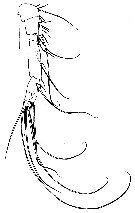 issued from : G.A. Heron & D.M. Damkaer in Smiths. Contr. Zool., 1969, 20. [p.8, Fig.9]. Male: A1. Scale bar: 0.100 mm. Nota : A1 5-segmented with 2 faint sutures. Armature similar to female except 1 less seta discerned on segment II and the section corresponding to segment V of female. A2, labrum, Md, Mx1 and Mx2, like those of female.
|
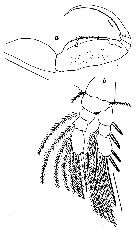 issued from : G.A. Heron & D.M. Damkaer in Smiths. Contr. Zool., 1969, 20. [p.9, Fig.10]. Male: a, Mxp; b, P1. Scale bar: 0.100 mm. Nota : Mxp differs of female, with 2 small segments between 2nd and terminal segments ; 2nd segment with 2 strong spines ; 4th segment with 1 long and 1 short seta.
|
 issued from : G.A. Heron & D.M. Damkaer in Smiths. Contr. Zool., 1969, 20. [p.5]. Female: Armature of swimming legs P1 to P4. Setae: Arabic numerals; Roman: spines; Si: inner borber of segments; Se: outer border of segments; St: terminal border of segments.
| | | | | Ref. compl.: | | | Deevey & Brooks, 1977 (p.156, tab.2, Station "S"); Suarez-Morales & Gasca, 2005 (p.257); Galbraith, 2009 (pers. comm.); Chiba S. & al., 2015 (p.968, Table 1: length vs climate) | | | | NZ: | 4 | | |
|
Carte de distribution de Pseudolubbockia dilatata par zones géographiques
|
| | | | Loc: | | | Azores, off Bermuda (Station "S"), Ibero-moroccan Bay, Gulf of Alaska, off British Columbia (rare), California (Monterey Bay) | | | | N: | 7 | | | | Lg.: | | | (676) F: 3,02-2,31; M: 1,4; 1,35; (677) F: 3,4; {F: 2,31-3,40; M: 1,35-1,40}
Chiba S. & al., 2015 (p.971, Table 1: Total length female (June-July) = 2.9 mm [optimal SST (°C) = 3.1]. | | | | Rem.: | bathypélagique.
Voir aussi les remarques en anglais | | | Dernière mise à jour : 28/09/2016 | |
|
|
 Toute utilisation de ce site pour une publication sera mentionnée avec la référence suivante : Toute utilisation de ce site pour une publication sera mentionnée avec la référence suivante :
Razouls C., Desreumaux N., Kouwenberg J. et de Bovée F., 2005-2025. - Biodiversité des Copépodes planctoniques marins (morphologie, répartition géographique et données biologiques). Sorbonne Université, CNRS. Disponible sur http://copepodes.obs-banyuls.fr [Accédé le 03 décembre 2025] © copyright 2005-2025 Sorbonne Université, CNRS
|
|
 |
 |













